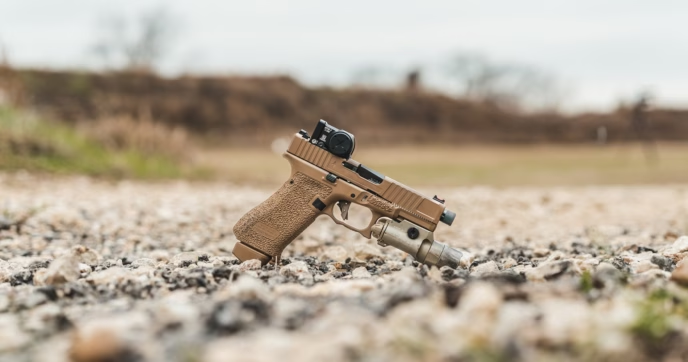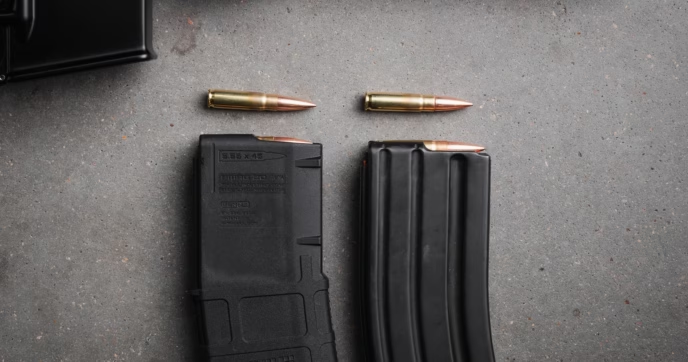Regardless of whether you’re a new firearm enthusiast or someone who’s been in the game for years, chances are you’re already familiar with the AR-15. Renowned for being one of the most adaptable rifle platforms ever made, it also has garnered a worldwide reputation as one of the most innovative firearms of the last century.
And over the years, the AR platform has served as the foundation for some of the most legendary rifle designs, including the M4, which has been the standard issue service rifle for the U.S. Military for quite some time. But as iconic as it is, it’s often erroneously labelled as just another AR-15, when that really isn’t the case.
If you’re unfamiliar with them, you may be wondering what exactly the M4 is and how it’s different from a civilian model AR-15. Below, we’re looking at both rifle systems and breaking down what it is that makes them different.

M4 Rifle Overview
The M4 is the standard issue service rifle for the U.S. Military, replacing the M16. Today it remains as one of the most common service carbines in the U.S. Military, although it will eventually be phased out by the SIG Sauer XM7. Introduced in 1994, the M4 is one of the most iconic rifle designs ever produced, seeing extensive use globally by both Military and Law Enforcement personnel. The M4 featured a more compact design compared to the M16, with a shorter barrel and collapsible stock to improve close-quarters handling.
In its base configuration, the M4 had a lot in common with the M16, such as the handguard, fixed front sight post, grip, and controls, but instead of using a 20-inch barrel, the M4 was outfitted with a 14.5-inch barrel as well as a shorter carbine-length gas system. While it kept a similar look to the M16 in its earlier M4 Carbine configuration, it eventually became the host to a set of upgraded components that were a part of the US SOPMOD program, further adding to the rifle’s utility and redesignating it as the M4A1 Block 1, and later, the M4A1 Block 2. Moving forward, it was common to see the M4 equipped with components like KAC RAS Handguard, optics, and more.
While the M4 in its various configurations bears resemblance to select civilian AR-15s, its defining characteristic is its lower receiver. Modern AR-15s built for the civilian market are exclusively manufactured in a semi-automatic configuration, meaning they only fire once per trigger pull. The M4, being a Military service rifle, is select fire, coming with either a three-round burst, or full-auto function, depending on its configuration. This makes it capable of firing either three rounds per trigger pull, or fully automatically until you let off the trigger. Because of this, the M4 is exclusively produced for Military and Law Enforcement Officers only.

AR-15 Rifle Overview
The AR-15 was first developed by Eugene Stoner and Armalite in the late 1950s and has since evolved into one of the most popular rifle platforms created. In its original configuration, it resembled the M16 rifle, coming with a longer barrel, fixed front sight post, a non-adjustable stock, and an upper with an integrated carry handle. Since then, it’s undergone a fair amount of design changes, with most AR-15 rifles today featuring a design that’s more in line with rifles like the M4.
Although the AR-15 can be built to the same general spec as the M4 (minus the full-auto feature, of course), commercial AR-15s often come equipped with more modern components and features such as free-floating handguards, improved furniture, and a bunch of other upgrades. The advances in AR-15 manufacturing have made it so that there are several unique AR-15 configurations to choose from.
Because of how adaptable these rifles are, every AR-15 has the capability to be upgraded with components that really tailor the rifle to each individual enthusiast. With the near endless array of aftermarket components available for them, the possibilities for your rifle set up are practically infinite. If you’re more interested in factory-built rifle, AR-15s are offered by a plethora of manufacturers like Daniel Defense, Sons of Liberty Gun Works, Diamondback Firearms, and many more. Each of them produces rifles for everything from recreational shooting and hunting to more dynamic applications like competitive shooting, duty, and home defense.
M4 vs. AR-15: Key Differences
At first glance, the M4 and civilian model AR-15s have a similar appearance and manual of arms, but as we’ve hinted at above, their differences go beyond their aesthetic presence.

Select-Fire vs. Semi-Auto
The greatest difference between the M4 and the AR-15 is the full-auto/three-round burst feature. Notably, all true M4s have a ‘full-cut’ lower receiver that accommodates the extra components found in select-fire triggers such as the auto sear and third pin. Civilian AR-15s can only be produced with a semi-auto function. As such many civilian lowers have what’s called a high shelf design, with the ‘shelf’, more specifically the space behind the safety selector, varying depending on the manufacturer
Notably, AR receivers will have either an M16, low shelf, or high shelf cut. An M16, or full, cut receiver is essentially milled identically to the M16/M4 lower receiver, including the cutaway for auto sear components, with full-cut civilian models lacking the third pin hole required for the auto sear. A low shelf receiver is similar to an M16 cut model, but it isn’t fully milled out and has thicker receiver walls comparatively. This makes them a viable host for registered drop-in auto sears (DIAS), but not the GI sear conversion. High shelf lowers are designed to have thicker receiver walls and aren’t milled nearly as much as low shelf and M16 cut lowers, ensuring they can’t accept any kind of auto sear without extensive milling.
Regardless of the cut, there are no civilian AR-15 receivers currently manufactured with select-fire functionality out of the box.
Barrel Length Differences
Where M4s must have a 14.5-inch barrel, a civilian AR-15 can come with just about any barrel length. It is worth pointing out that civilian rifles must have either a 16-inch or longer barrel to be a legal rifle. Keep in mind that you can use a 13.7-, 14.5-, or a 14.7-inch barrel, so long as the muzzle device is pinned and welded to the barrel, and long enough to bring its total length to 16-inches or longer.
The Daniel Defense M4A1, for example, is configured this way, coming with a pinned and welded 14.5-inch barrel. If you don’t use a pinned and welded muzzle device or opt for a shorter barrel like an 11.5- or 12.5-inch one, the rifle is considered and SBR (Short-Barreled Rifle), which requires a tax stamp and ATF approval to own.

Differences in Design and Functionality
As we’ve mentioned thus far, the M4’s design is strictly bound to the Military’s specifications, limiting its overall variety. Most M4s still use a fixed front sight post and drop-in handguards, retaining their original design. However, select M4s are equipped with a more modern URGI (Upper Receiver Group Improved) upper receiver that’s equipped with a low-profile gas block and a free-floating M-LOK rail from Geissele. Similarly, Block II M4s are often outfitted with a Daniel Defense RIS II quad rail handguard, which we highlight in our Daniel Defense review.
These handguards are not only lighter, but more functional too since they’re longer and provide more space for mounting accessories like sling mounts, grips, lights, and laser units. While effective, compared to Civilian AR-15s, the M4 is limited in what it can be outfitted with since it’s bound to its mil-spec standard. Civilian ARs aren’t adherent to such specifications, allowing manufacturers to make them in several unique variations with specialized components.
One key area where civilian AR manufacturers have more freedom of choice is in the receivers. M4s utilizes a mil-spec upper and lower receiver, forged from 7075-T6 aluminum. Many civilian AR-15 models use similar receivers, but some manufacturers often produce more unique receiver options such as forged lowers with added features or different designs, or a billet receiver that’s entirely unique to the manufacturer. Billet receiver sets are most often milled from a block of 7075-T6 aluminum, and we go more in-depth on the differences between them in our guide “Forged vs. Billet Lower Receivers”.
Regardless of which one you look at, each receiver type can have a design that can enhance the rifle’s manual of arms. For instance, Sons of Liberty Gun Works offers a billet receiver set that features a lower with ambidextrous controls, giving you full access to your rifle’s controls regardless of your shooting position or dexterity. Manufacturers can make forged lowers like this as well; they just aren’t as common to find like with billet lowers.

Performance and Caliber Differences
In terms of each rifle’s respective performance, the M4 is a good general-purpose rifle that excels in close quarters use as well engaging targets up to around 500 yards away. The performance of civilian AR-15s can vary since they’re entirely dependent on how they’re configured.
Take long-range shooting for example. An AR-15 built for such a purpose can be equipped with a longer barrel and other components to make it more suitable for this application—especially so when paired with specialty 5.56 loads or other calibers that are designed for long range shooting. For better efficacy in a CQB setting, AR-15s can be configured with shorter barrels to make them into a more compact, PDW-style rifle. This adaptability makes the AR platform a true jack of all trades—one that can offer incredible performance in just about every application, given the right set up.
Regardless of what purpose your AR is built for, the caliber you use plays a significant role in its performance. Due to its mil-spec requirements, the M4 must be chambered in 5.56 NATO, while civilian AR-15s can be chambered in several different calibers that suit different applications.
Cartridges like .300 Blackout use a larger .30 caliber projectile that gains velocity and stabilizes much quicker than 5.56 NATO, making it an ideal cartridge for builds with shorter barrels. Plus, since it’s such a low-pressure cartridge, it’s easier to suppress, and can offer hearing safe performance depending on the loading.
Going back to long range shooting, calibers like 6.5 Grendel and 6mm ARC are better suited for such purposes. Both can reach much higher muzzle velocities and can consistently hit targets up to and beyond 1,000 yards, while 5.56 has an effective range of around 500 yards, unless you’re using a specialized load.
Conclusion
The AR platform is without a doubt one of the most adaptable and legendary rifle platforms ever created, serving as the basis for several unique rifle systems such as the M4. Because how similar the Military’s M4 and civilian AR-15 models are, it’s important to understand what distinguishes both rifle platforms.
On the surface, the M4 and AR-15 share a similar manual of arms and are built from many of the same components. However, they have their distinctions. Simply put, the M4 is a specific AR-15 configuration adopted by the U.S. Military that uses a select fire lower receiver, and other specific components. In contrast, civilian AR-15s aren’t designed for military applications so they aren’t bound to any mil-spec standards, allowing them to feature several unique designs that are tailored to different applications.
Ultimately, the M4 has proven itself as a historically significant and specialized tool for use by Military and Law Enforcement groups, while civilian AR-15s can be set up for any enthusiast’s needs. If you’re interested in building or buying an AR-15, but don’t know which brands to consider, we recommend checking out our Sons Of Liberty Gun Works review, as well as other articles on the Primary Source.




